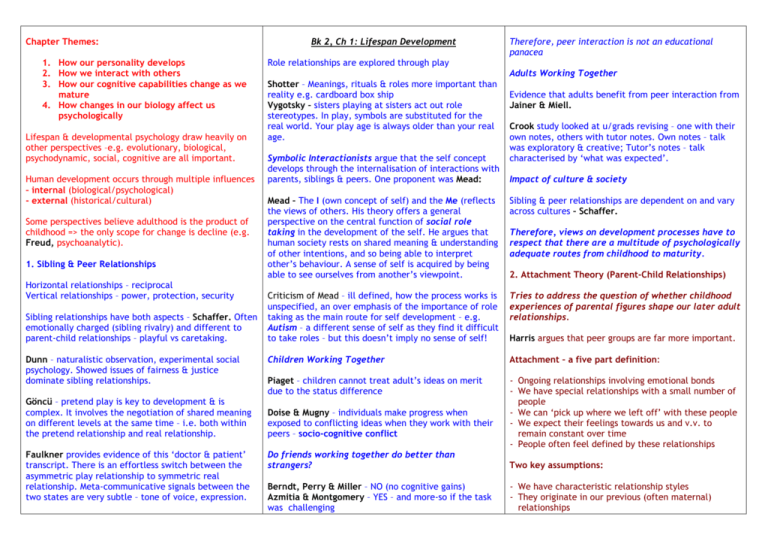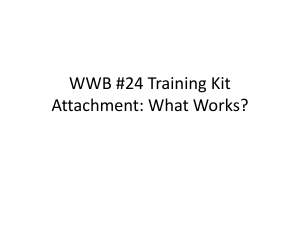Chapter Themes: 1. How our personality develops 2. How we
advertisement

Chapter Themes: 1. How our personality develops 2. How we interact with others 3. How our cognitive capabilities change as we mature 4. How changes in our biology affect us psychologically Lifespan & developmental psychology draw heavily on other perspectives –e.g. evolutionary, biological, psychodynamic, social, cognitive are all important. Human development occurs through multiple influences – internal (biological/psychological) - external (historical/cultural) Some perspectives believe adulthood is the product of childhood => the only scope for change is decline (e.g. Freud, psychoanalytic). 1. Sibling & Peer Relationships Horizontal relationships – reciprocal Vertical relationships – power, protection, security Sibling relationships have both aspects – Schaffer. Often emotionally charged (sibling rivalry) and different to parent-child relationships – playful vs caretaking. Dunn – naturalistic observation, experimental social psychology. Showed issues of fairness & justice dominate sibling relationships. Göncü – pretend play is key to development & is complex. It involves the negotiation of shared meaning on different levels at the same time – i.e. both within the pretend relationship and real relationship. Faulkner provides evidence of this ‘doctor & patient’ transcript. There is an effortless switch between the asymmetric play relationship to symmetric real relationship. Meta-communicative signals between the two states are very subtle – tone of voice, expression. Bk 2, Ch 1: Lifespan Development Therefore, peer interaction is not an educational panacea Role relationships are explored through play Adults Working Together Shotter – Meanings, rituals & roles more important than reality e.g. cardboard box ship Vygotsky – sisters playing at sisters act out role stereotypes. In play, symbols are substituted for the real world. Your play age is always older than your real age. Symbolic Interactionists argue that the self concept develops through the internalisation of interactions with parents, siblings & peers. One proponent was Mead: Evidence that adults benefit from peer interaction from Jainer & Miell. Crook study looked at u/grads revising – one with their own notes, others with tutor notes. Own notes – talk was exploratory & creative; Tutor’s notes – talk characterised by ‘what was expected’. Impact of culture & society Mead – The I (own concept of self) and the Me (reflects the views of others. His theory offers a general perspective on the central function of social role taking in the development of the self. He argues that human society rests on shared meaning & understanding of other intentions, and so being able to interpret other’s behaviour. A sense of self is acquired by being able to see ourselves from another’s viewpoint. Sibling & peer relationships are dependent on and vary across cultures – Schaffer. Criticism of Mead – ill defined, how the process works is unspecified, an over emphasis of the importance of role taking as the main route for self development – e.g. Autism – a different sense of self as they find it difficult to take roles – but this doesn’t imply no sense of self! Tries to address the question of whether childhood experiences of parental figures shape our later adult relationships. Children Working Together Attachment – a five part definition: Piaget – children cannot treat adult’s ideas on merit due to the status difference - Ongoing relationships involving emotional bonds - We have special relationships with a small number of people - We can ‘pick up where we left off’ with these people - We expect their feelings towards us and v.v. to remain constant over time - People often feel defined by these relationships Doise & Mugny – individuals make progress when exposed to conflicting ideas when they work with their peers – socio-cognitive conflict Therefore, views on development processes have to respect that there are a multitude of psychologically adequate routes from childhood to maturity. 2. Attachment Theory (Parent-Child Relationships) Harris argues that peer groups are far more important. Do friends working together do better than strangers? Two key assumptions: Berndt, Perry & Miller – NO (no cognitive gains) Azmitia & Montgomery – YES – and more-so if the task was challenging - We have characteristic relationship styles - They originate in our previous (often maternal) relationships Categorical Approach to Attachment Core Attachment Concept – Internal Working Models 3. Later Development Hazan & Shaver – ‘Love Quiz’ Bowlby – ‘there is a biological drive to achieve security through the ‘mother figure’ (c.f. imprinting on chicks) Age can be defined many different ways: Three answers to determine (adult) style – resulting in categories of: Model of Infant Model of Reltnship Model of Mother Secure Insecure (anxious-ambivalent) and Insecure (anxious-avoidant) Ainsworth – ‘Strange Situation’. Repeated separations & re-unions; observation of child to determine infant attachment. Criticism – are these styles exhaustive, exclusive, stable, context-dependent, accurate, biased? The ‘quiz’ was also a self-report measure – prone to ‘socially desirable’ responses (>50% fell into the ‘Secure’ style) Type A – Insecure, anxious-avoidant; stress at separation, ignores stranger, still upset at reunion, pessimistic Type B – Secure; ok at separation, pleasure at reunion Trait Approach to Attachment Bartholomew – located people along bipolar traits: Model of Other Type C – Insecure, anxious-ambivalent; stress at separation, some response to stranger (aggression?) Model of Self Autonomy Dependence The contention is that A,B,C show different internal working models Approach Secure Pre-occupied Avoidance Dismissing Fearful Criticisms – ethics, ‘it’s too strange’ (lab expmnt), previous separations influence results. All countered by advocates. Contradictory findings: Adult Attachment Interview Main – Pre-determined interview, fixed questions resulting in three possible positions: Insecure – dismissing – childhood experiences were not important to me Secure – autonomous – acknowledgement of the importance of past & present relationships Insecure – pre-occupied – lengthy answers, no clear structure, ‘stuck’ in unresolved issues of the past. Main also believed it was possible to achieve ‘earned security’ – a difficult childhood, but factors such as a positive marriage relationship resulting in a secure attachment style. Bielefeld (Germany) - longitudinal study – SST poor predictor of AAT Hamilton (USA) – SST good predictor of AAT Chronological – time Biological – body Social – attitudes Psychological – adaptability Functional age – in terms of ability, but younger=better? Erikson – Psychosocial Development & Crises (an example of an organismic stage theory) Trust v Mistrust 0-1 yrs Autonomy v Doubt 1-3 yrs Initiative v Guilt 3-6 yrs Industry v Inferiority 6-11 yrs Identity v Role Confusion Teenage yrs Intimacy v Isolation 20’s & 30’s Generativity v Self absorb 40-65 Integrity v Despair 65+ Strength: one of few theories to consider development in later life; Weakness: Later life is characterised in very narrow terms Peck argues this underestimates the complexity of later life; sub divided the last two stages: Middle Age: Valuing Wisdom vs Physical powers Socialising vs Sexualising Cathectic flexibility vs impoverishment Mental flexibility vs Mental rigidity Old Age: Ego differentiation vs work-role preocc Body transcendence vs body preocc Ego transcendence vs ego preocc Changes happen between SST and AAT. Consistent findings: -from a meta-analysis by van Ijzendoorn. Mother’s AAT predicts infant SST (75%) AAT predicts how mother’s behave towards infant Maternal sensitivity predicts infant’s SST Attachment tells us about relatedness - The capacity a person has to relate to another & the way they approach a r’ship – r’ships result from attchmt interplay Hope Will Purpose Competence Fidelity Love Care Wisdom Weakness: Culturally specific, western bias, universal experience’s of aging (Peck’s) assumed. Erikson & Peck are both person centred views A function centred view comes from Baltes: SOC Successful ageing = maximising gains; minimising losses Selection, Optimisation, Compensation (piano player) Examples: 1. Memory 4. Approaches to Lifespan Development 3. Developmental Contextualism Ribbot’s Law – the past is better remembered than the present (episodic memory). 1. Functionalism Argues that development is affected by the context of an individual’s life and so does not occur in isolation from it. Holland & Rabbitt found true for those in care; false for those living in the community – as a greater reliance on memory required for successful community living. Qualitative changes take place in ageing, not decline. Maylor studied ‘Mastermind’ – General Knowledge improves with age. Kensinger & Schacter showed that while young adults recalled more words from lists that were semantically associated with a ‘false’ target word they also had fewer ‘false’ items – therefore shows older people use ‘the gist’ – semantics – when recalling. 2. Intelligence Weschler adult intelligence scale – we experience cognitive losses (same as we decline physically). But, depends on how intelligence is characterised. From Darwin – explanations as to why behaviour changes based on the idea that change will serve new & adaptive purposes –e.g. Attachment theory has a functional explanation, as do social relationships. Internal Influences + External Influences = Development (bio, psych) (culture, r’ships) 2. Organismic Approaches This intertwining is known as embeddedness. Concerned with when changes in development ‘normally’ occur – stage theory. Freud’s psychosexual theory is an example. Another comes from Piaget. Change any variable & it causes changes in others at any level of explanation – this is dynamic interactionism. He found that systematic errors were made on an intelligence test, and argued that these errors held the key to how children’s reasoning abilities develop with age. Genetic Epistemology – the development of intelligence as a form of adaption to the environment. Bronfenbrenner: Model of Development Microsystem: the immediate environment Mesosystem: two or more Microsystems inhabited by the same person Exosystem: links between settings, 1 or more of which is inhabited by the developing person patterns of the first three that make up a culture. Four main stages: Sternberg argues we demonstrate intelligence in the way we adapt to our environment, and the best way to test intelligence is to give people novel tasks or by observing the automatisation of new skills, as being able to do a task this way frees up cognitive resources. Sensory Motor stage ages 0-2 Innate behavioural patterns Pre-operational stage ages 2-6 Use of sequences of actions Macrosystem: Horn and Cattell older people do better on tasks that require experience Concrete Operations ages 6-12 Development of rules. (It makes more if you add). Not able to anticipate something that could happen that they haven’t experienced Strength: Shows people can promote their own development Crystallized Intelligence vs Fluid Intelligence (cultural knowledge) (brain function) This is the Baltes two component model. Schaie & Willis obtained longitudinal data (minimising cohort differences) that showed IQ does not decline after age 70 – different result to cross-sectional study designs Schaie used earlier. Instead, older people’s reasoning is socially & contextually oriented – e.g. meadows and houses task. Adult thought is characterised by dialectical maturity – the ability to cope with contradictions! Formal Operations ages 12+ Abstract reasoning. Model of the world that can account for nearly everything. Implies adults demonstrate intellectual maturity in this way. Criticism: Formal thought is the ideal (white, middleclass) Kircheloe & Steinberg argue cognitive development is not static, that it interacts with the environment and is infinitely malleable. Piaget’s theory underestimates interpersonal contacts & ignores lifelong development potential. Conflicts with attachment theory. Organismic stage theories suggest little development is possible in adulthood. Developmental contextualism explicity acknowledges that adult development happens.







